Data Analytics Assignment: Issues Relating To Business Process Analysis
Question
Task:
Data Analytics Assignment Task 01: Business Process Re-engineering (BPR) for safety and operational excellence
Michael Hammer and James Champy (1993), define business process reengineering as “the fundamental rethinking and radical redesign of business processes to bring about dramatic improvements in critical, contemporary measures of performance, such as cost, quality, service, and speed.”
In the wake of the COVID-19 crisis many businesses and public institutions around the globe were forced to rethink of their operational processes, not least for the concern of safety for their customers and employees but also for adjusting and even improving on other important operational performance measures such as scalability, speed, costs etc to cope with and excel in the new reality.
In this backdrop, you are expected to facilitate a significant BPR effort at your workplace (or *any other suitably large enough public/private institution) to re-engineer its existing operational process(es). Assume the organization is not just for striving for coping up with the present (or future) pandemic situation(s) but also aimed at excelling during and post-pandemic times.
1.a) Map the organizations present (or pre-reengineered) operational processes with the aid of a high-level Use Case Diagram/ Top Level DFD in order to provide an overview model of organization’s key operational processes in context.
Also provide a very brief description of each process and discuss their alignment to organization’s mission & strategy, identify any lapses and/or opportunities for improvement.
1.b) Choose one process with sufficient scope that could greatly benefit from or warrants a BPR (Business Process Reengineering) intervention. Provide justification for the basis of selection.
1.c) Prepare separate stakeholder management plans for Sponsor and one another High Power /High Interest (either or both) stakeholder of this BPR project
1.d) Conduct elicitation on the selected process and
- Produce the ‘as-is model’ and the ‘process description’ of the existing (prior to reengineering) process
- Produce the ‘to-be model’ and the ‘process description’ for the (proposed) reengineered process
- Discuss both processes clearly highlighting process lapses, measured limitations and opportunities for significant improvement and innovation with expected benefits.
1.e) Produce a detail specification for the reengineered process that covers process values, KPIs, symptoms of noncompliance, methods of improvement and any other important details and underlying assumptions.
Sri Lanka Railways (SLR): Business Process Reengineering (BPR) and Change Management
Prior to the COVI-19 outbreak Government of Sri Lanka with the financial assistance of Asian Development Bank (ADB) had envisioned a program to modernize Sri Lanka Railways (SLR). The program would consist of a series of high impact subprojects to modernize the railways by improving the operational efficiency, maintenance capacity, safety, skills development, and implementation capacity of SLR.
As with the current SLR operations, automation is very limited, and most planning, operating, and recording activities are carried out manually. For Example;
SLR Ticket Issuance:
Paper tickets are printed at SLR headquarters, and typesetters must manually arrange the letterpress blocks for the 60,000 ticket combinations frequently requested. Physical tickets are then sent by train to each station. Once purchased by passengers, daily ticket sales are then manually logged (handwritten) by ticket type and destination at each station, and revenues and records are sent by train back to the headquarters. Revenues are then coded in a database, and summary reports are generated on a monthly basis. The overall process requires a very significant workforce for printing, dispatching, writing, and coding, and is therefore prone to error. (adopted from ADB Technical Assistance Report (July 2019): Project Number 49111-005)
Having faced up to a pandemic situation, assume the GOSL want to expedite the task of reengineering the whole ticket issuing process with the objectives of improving passenger and staff safety while achieving significant gains in other applicable operational performance measures.
Assuming you are requested to provide consultancy to the SLR on a viable reengineered operational model for the whole Ticket issuing process, answer tasks 1.f and 1.g.
1.f) Produce a schematic diagram [i.e. Swimlane diagram or DFD] of the “reengineered operational model” for SLR ticket issuance. Discuss and compare the new operational model with the present operations, in terms of its strengths, technical implementation aspects, operational feasibility, and cost implications with respect to main stakeholders such as SLR, Staff and Passengers. Clearly state any assumptions made.
1.g) BPR projects often bring along significant change to the current status quo of how things are being done. In spite of the urgency created by the pandemic situation the envisioned change at SLR still need to be carefully planned out and executed for it to be a complete success.
With the aid of suitable change management models/ techniques propose how the transition from the current system of ticket issuance to the new approach could be implemented successfully by the SLR.
Task 02: Numeric prediction with linear regression
Given is a sample data set (medExpense.csv) which contains 1,340 examples of beneficiaries currently enrolled to a health insurance plan, with features indicating characteristics of the insured individual as well as the total medical expenses charged to the plan for the calendar year.
Preform the following tasks and provide evidence through well commented code snippets, results/output, and visualizations accompanied with your interpretation/discussion as appropriate in the assignment report itself
2.a Load the medExpense.csv file in to R (RStudio) and explore the given data set.
2.b Check for the existence of any relationships among features.
2.c *Partition the given dataset as 75% for Training data and 25% for Test data, make sure you set the seed value to 123.
2.d Build a model (multiple linear regression) to predict medical expenses with all other features and train it on the Training data. Evaluate model performance on Training data.
2.e Modify and improve you model further for optimal performance, clearly state any assumptions or steps taken in this regard. re-evaluate your optimal model against the Training data.
2.f Use the optimal model to predict medical expenses on the Test data, plot predicted versus actual expenses and report the correlation between them.
2.g Suppose you are required to suggest alterative machine learning algorithms for the same problem, recommend any two suitable algorithms, provide appropriate justification for their selection.
Task 03: Emerging trends
From a ‘Business Analyst’ perspective discuss the following concepts
- Process Mining
- Intelligent Process Automation
- Sentiment Analysis
Your discussion should provide a definition of the concept, its potential business application area(s), benefits and any limitations/risks with suitable real-world implementation examples.
Answer
Data Analytics Assignment Task 01: Business Process Re-engineering (BPR) for safety and operational excellence
Task 1a:
The restaurant management system data flow diagram helps in creating an overview of restaurant with minimum details. It consists of an overall application dataflow and processes related to restaurant processes. The flow chart diagram consists of flow of restaurant, items, employees, sales, orders etc.
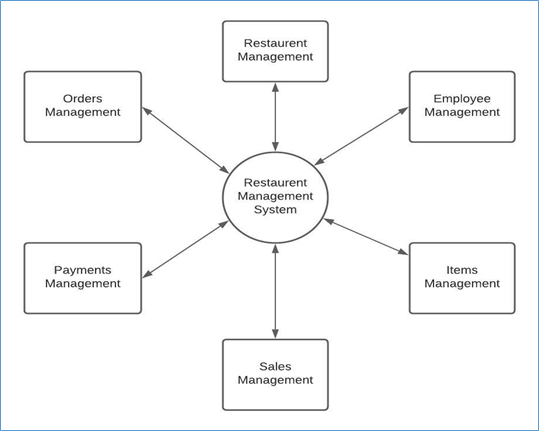
Figure 1: level 0 DFD of restaurant management system
[source: created by the author]
In the Zero level data flow diagram, it defines the high level process of restaurant. It provides an overview related to whole restaurant management process which is been analyzed or modeled (Yüzba??o?lu et al., 2020). It can be easily understood with the audience that includes items, restaurants and payments.
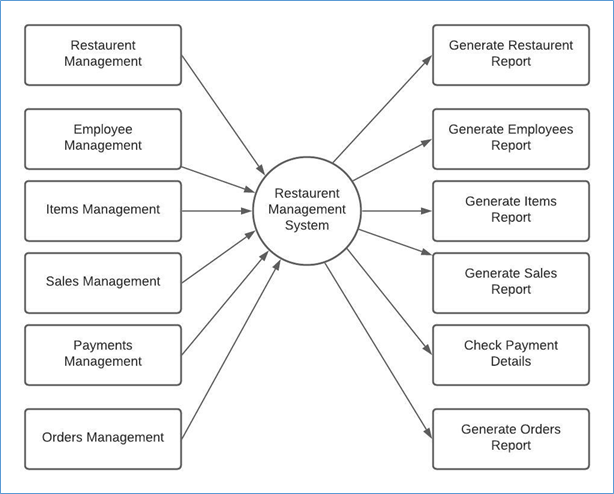
Figure 2: Level 1 DFD of restaurant management system
[Source: Created by the author]
In the First level data flow diagram, it shows how the works that is divided in process of sub systems. Each of those deals with the internal data stores of item category that includes payments, items, orders and sells. It helps in providing out a detail output with the 1st level data flow diagram (Takenaka, 2020).
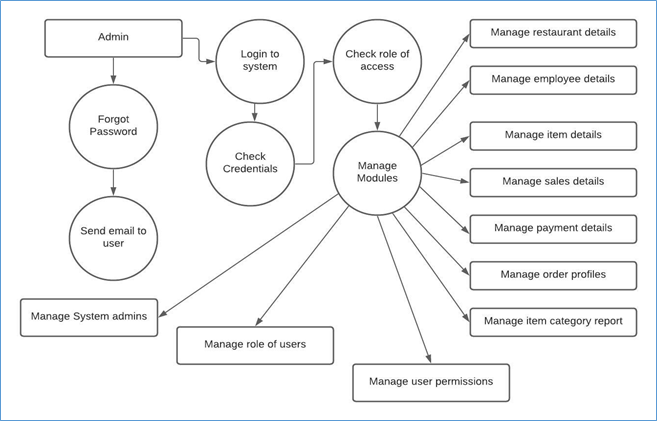
Figure 3: Level 2 DFD diagram of restaurant management system
[Source: Created by the author]
In the Second level data flow diagram, it is one more step deeper in portions of level 1. It does require several functionalities of restaurant that will help in reaching necessary details related to the Restaurant Management System. In 2nd level data flow diagram, it comprises of more details related to payments, items, orders and sells.
Task 1b:
The one process which is selected for BPR (Business Process Reengineering) intervention is upon is Food ordering system. The food ordering system has changed dynamically and have a rapid growth in industry. With the implication of online food ordering system, the system has evolved with the help of mobile based platforms and applications. In introducing food ordering system, it will safety upon electronic payments and there will be a rise in demand with several meal options which will be provided in presenting major factors (?????????, ?????? and ?????, 2020). There is a wide reach and have frequent use with food ordering system that help in representing a way with the help of several behavioral strategies which help in support of public health nutrition with large number of people on a regular basis. With the changes in food orderings system, it will help several consumers in placing orders virtually anytime from any place. It will help ultimately in saving the time of consumers that will consumer time at travelling (Athulurutlrumala and Attuluru, 2019). With online food ordering system, it will reduce labor work and effectively staff work is reduced as it will replace the machinery. The consumers will also have the option in customizing food at the time of ordering food.
Task 1c:
Stakeholder managements is a critical process which do lead to success in every project. It is considered as a strategic discipline which the project managers use in sustaining support for the projects from others both from the external and internal project. The stakeholder management do have a wide approach with project team that will help the stakeholders to make project successful and will have a key project success (Ahmed and Shahrear, 2017). It is a process that helps in managing stakeholders through a plan of action and communications with life of project. The stakeholder management approach is unique and can be changed with several implications based on the project (Karpi?ski, 2018). In developing a stakeholder approach, the manager of project will have to take control of stakeholder management which help in building stepwise analysis of stakeholder analysis. In the starting of stakeholder analysis, it helps in capturing and document related to shareholder information, and the process will be carried out by project manager and project leads with the customer stakeholders (Bell et al., 2020). After this process, there will be analysis of power, importance, relevance, interest and demand of stakeholder. After the collection of data and information a complete analysis is provided and a stakeholder management plan will be prepared accordingly.
Task 1d:
As-is process:
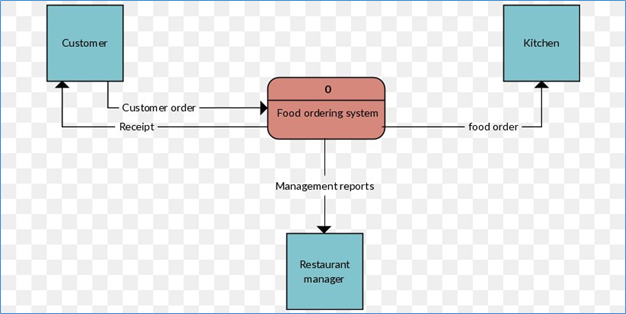
Figure 4: As-is process of restaurant operations
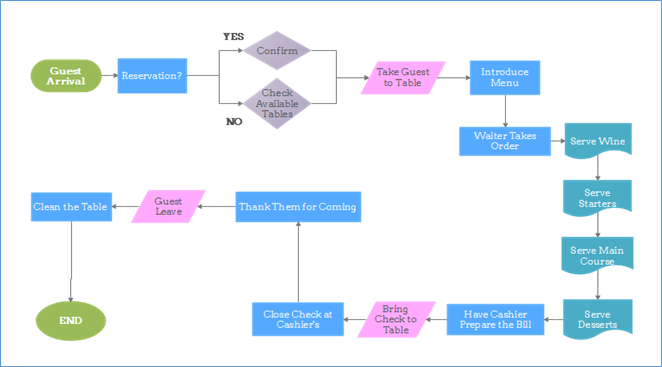
Figure 5: To-be process of restaurant operations
Café Process for dealing with an eatery
This alludes to the top administration part in a café. This piece of café the board dwell with the eatery proprietor. As an eatery proprietor, the job is to decide the arrangement, objectives and targets. The job is to survey these objectives in quarterly or yearly audit. Café proprietors part of giving assets, make estimates also, speaking with the group. As a piece of the activity plan the restaurant may have to audit the opposition or then again plan advancements.
Café Process for overseeing assets
Every nonexclusive cycle needs assets, read as, man, material, machines and climate. Cycle 1,3 and 4 asset needs arranging and conveyance. As an eatery proprietor, how can one request assets, who supports them.
Café Process for observing and estimating results
The thought is to be information driven. Who incorporate data. Who use what framework to produce reports. What's the nature of procurement, preparing, consumer loyalty.
Café Process for acknowledgment of the item
This is the thing that the client purchases. For our situation food and refreshment. How and how we deal with get it going. In a café this would consider with bar, administration and kitchen.
Divisions versus Process
Divisions are coordinated vertically and cycle on a level plane. Doesn't buy affect everybody? The nature of support sway the nature of administration and creation and in this manner the client. The effect on sanitation are affected by buy, housekeeping, support, administration, kitchen.
A process approach can help you the eatery proprietor for better café the executives and to be in a more noteworthy command over the fate of your eatery. It can empower you to achieve improvement in the manner your association works together. You will perceive that client disappointment might be a direct result of low quality in distance office. The restaurant will be information driven and your answer will approve your information.
Task 1e:
In system engineering process, it helps the system in satisfying several objectives and practice certain functions. The system will consist of hardware, people, software and data (Kuzmin et al., 2018). With the system engineering process, it will take initiative and have a structural approach in developing the system and help in filling various objectives. With the help of system engineering, it helps in managing both management and technical aspects of system. In terms of technical aspect, it helps in transforming operational needs into the specified system (Yucedag, Kaya and Cetin, 2018). The management aspect helps in involvement and creating system that consist of managing and implementing process, cost, monitoring schedule and the processes in fulfilling objectives. The process is usually gathered and allocated in lower levels. The process of allocation does have several parts of requirements lower level of the system (Vick and Panigrahi, 2021). At the time of process allocation, there are several changes that are been used based on derived requirements, and the process which is transformed in design phase. The assessment based on the capability of system will have certain requirement upon verification. This verification test will include demonstration, examination, testing and documentation methods.
Task 1f:
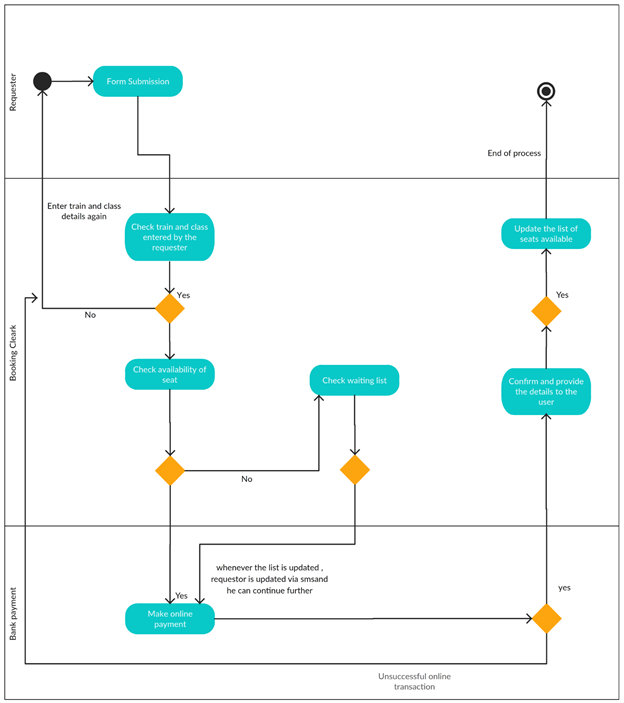
Figure 6: SLR ticket issuance data flow
Looking at the case study given, it can be said that the railway stations of Sri Lanka are facing several issues in managing the daily operational activity. As the ticket issuing system still depends on printing of paper tickets; therefore, purchasing the tickets without visiting to the railway station is clearly impossible. As the whole system relays on manual action and records are also maintained manually; hence, level of delay and difficulty always remains high. Staffs face higher difficulty in monitoring and managing the overall performance. In addition to that, chances of occurrence of invalid ticket are always high. Therefore, the government of Sri Lanka needs to upgrade the railway station performance ability by adopting a new and efficient operational model. Analyzing the entire situation, it can be said that an automated ticket issuing system (ATIS) will be a suitable operational model (Strelko et al., 2019).
Stakeholders analysis
Stakeholders hold higher importance in successful completion and running of every project. Therefore, it is essential to adopt and implement the operational model by considering all the internal and external stakeholders of this project. In this case, railway station staffs, administration, system engineers, passengers and railway conductor are act as the internal stakeholders. Meanwhile, the government of Sri Lanka, the mobile and internet service providers, banks and ICTA will be the external service providers.
ATIS as the new operational model
Going beyond the traditional methods, Automation has provided list of ways for integrating almost all kind of business processes. Likewise, automated ticketing issuing software introduces a brand new optimized way for managing the tickets and enabling customer interaction in a better manner (AHMAD, 2019). In order to make effective and seamless customer support, it is essential for the railways to create and maintain multi-channel interaction. By avoiding the entire unnecessary manual processes, automation integrates the whole ticketing process of railway starting from ticket creation to its resolution. This automated ticket issuing system (ATIS) mainly focuses on selling the rail tickets (D'silva et al., 2017). The main requirement of this system is that, it should be fast enough for handling the bulk transaction and must possess ability of ensuring higher security to the passengers.
Operation process
The process starts by users selecting their current station and destination and then they have to input their credit card number alongside their personal identification number. The rail ticket is then issued to the passengers and the related credit card account is charged. After the user presses a start button, a menu displays of having several potential destinations gets activated. Additionally, a message is generated to the passenger for selecting the destination (Venkatraman, Shankar and Chalapathi, 2018). The user has to give his/her required credit card details after selection of correct destination. The system will check validity of the card entered and after that the user is requested to input a personal identifier or mobile numbers. After validating the credit transaction, ticket is issued to the passenger.
Benefits over traditional process
Major benefit that can be gathered from this integration is performing lesser manual operations, thereby saving the time and money. Generation of ticket automatically and closing or elimination of duplicate and invalid ticket will be achieved. In addition, error free outcome can be collected by eliminating number of manual processes. This system also holds ability of tracking the whole conversation record carried out between the end users and the IT team. Without any manual touch it can track every process from ticket creation to resolution. Hence, in case of any escalation, solution can be found within a few minutes. As, smoother communication between the railway IT team and end user holds major importance; hence, this automated system provides accurate and speedy resolutions for better experience. Connecting with the passengers and carrying out internal staff communication will become much easier (Sani, Usman and Adamu, 2019). In contrast to the traditional ticketing system, the ATIS not only create tickets, by providing facilities of sending emails, both the user and the IT team can initiate smoother and better communication. This is one essential factor provided by the automatic ticketing system, which is missed by the conventional ticketing method available at the railway stations of Sri Lanka. Hence, the passengers will have flexible facility of booking their ticket anywhere and anytime. In addition to that, different from the traditional process, it provides centralized control for monitoring and auditing the whole process. The credit card along with mobile based payment option provided here enables flexible purchasing of the ticket.
Task 1g:
Business process reengineering is one essential practice that integrates the service providing of any organization. Inspiring and driving any change has always become challenge for every organization. Therefore, adoption of appropriate change management model is essential to enhance the ongoing performance ability and addressing the current key issues (Pollack and Pollack, 2015). Kotter’s change management model is one effective and popular model that focuses and shapes the employees’ response towards the change. It has eight different stages that will help the railways of Sri Lanka to implement the new operational stage successfully.
- By creating a sense of urgency it motivates and encourages the employees to show effective engagement in the entire process.
- By building a team, it determines the actual set of skills and knowledge required for driving the change successfully in favor of the SLR.
- It gives a clear translation of the vision to the employees. Apart from focusing on the strategy creation, it also focuses on employees’ emotion, creativity and objective towards the project,
- Frequent and transparent communication related to the process can also be expected from this model.
- It provides facility of collecting support from all the stakeholders, removing the roadblocks and implementing the process successfully.
- Motivation is given to the employees for focusing in the short term goals.
- It incorporates the change by helping the employees to adjust and operate with the new implemented model (Galli, 2018).
- The model believes that changes do not happen overnight and any type of obstacle is clearly unavoidable. Hence, it is essential for the employees to stay motivated.
Task 02: Numeric prediction with linear regression
Task 2a:
Data summary:
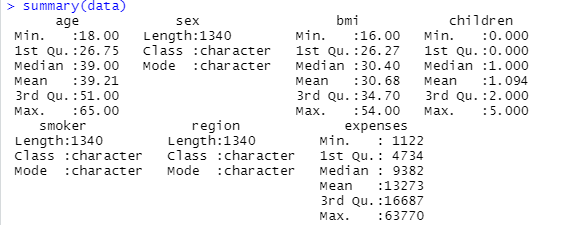
Histograms:
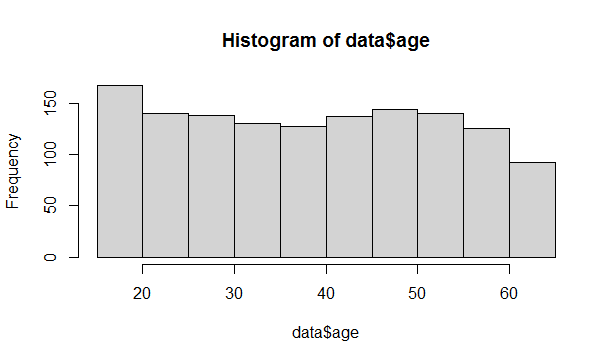
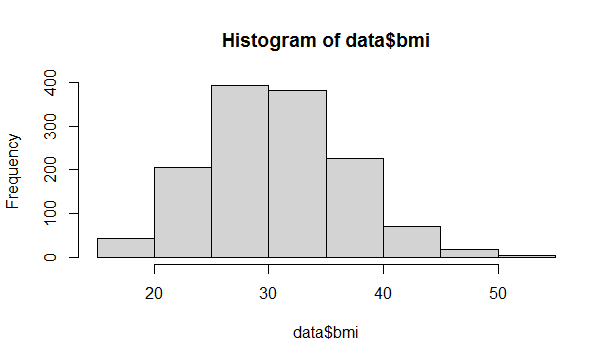
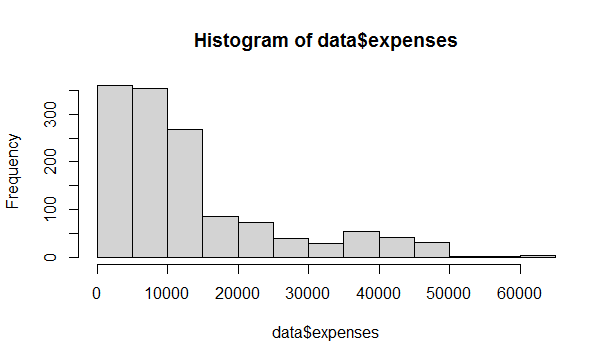
Frequency distribution table:
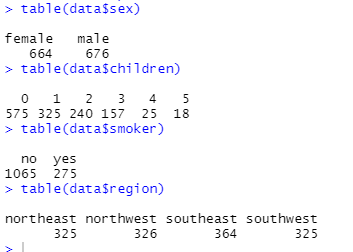
Task 2b:
Scatter plot of age vs Expenses
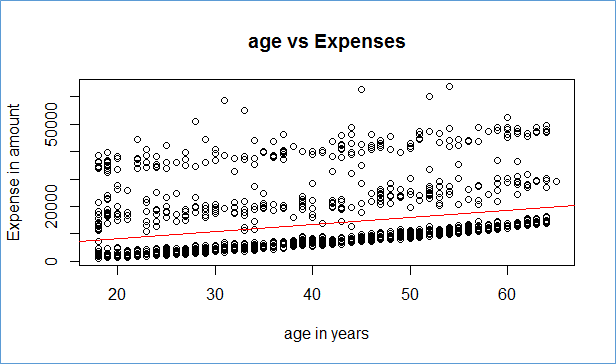
Scatter plot of bmi vs Expenses
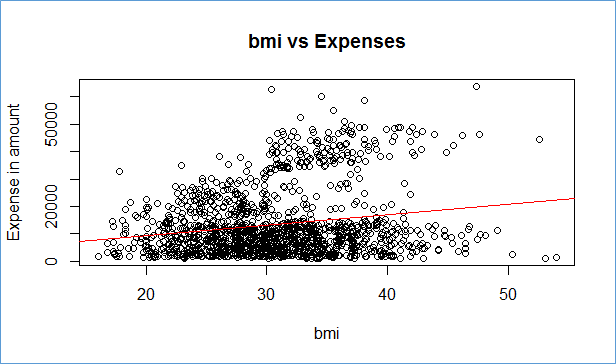
Task 2c:

Task 2d:
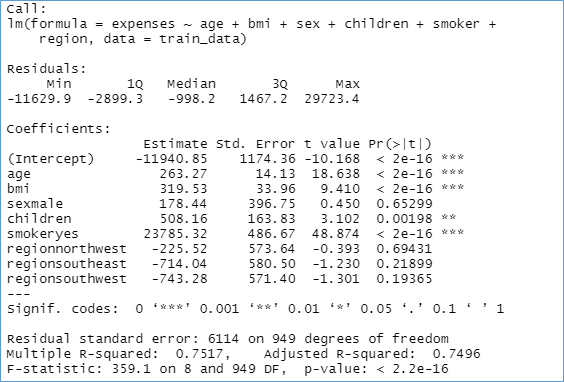

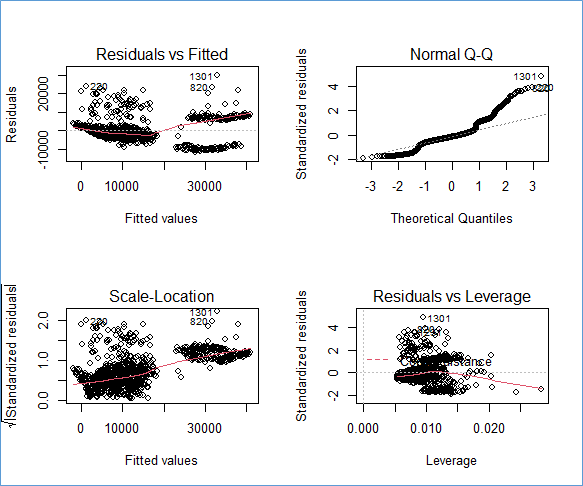
Task 2e:
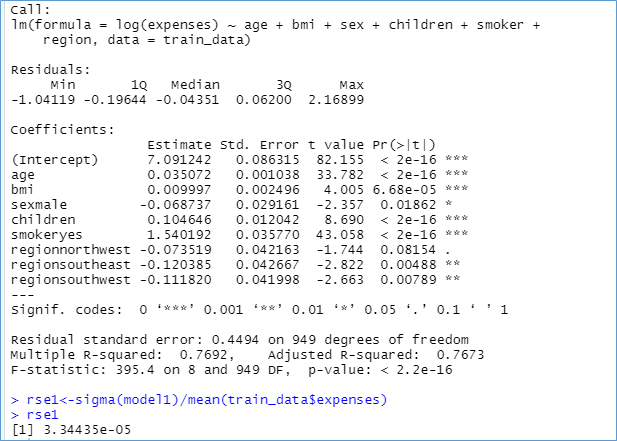
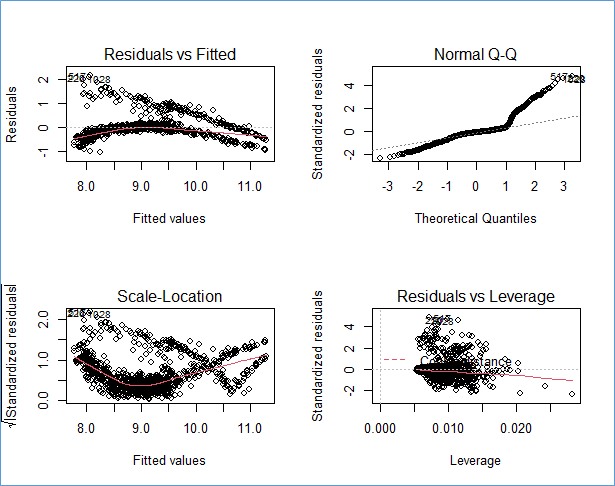
Task 2f:
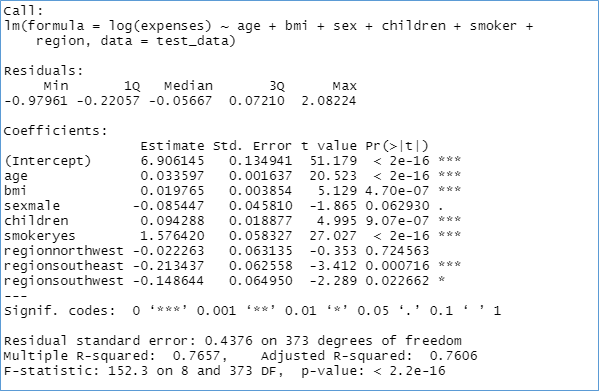
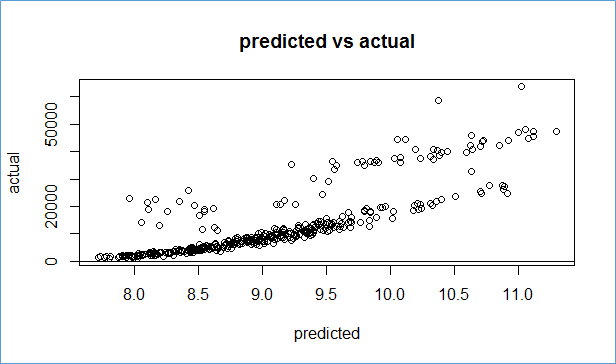
Task 2g:
Alternatively, here, the analyst can adopt correlation analysis, which will enable to find out the association between dependent and independent variables. At the same time ANOVA test can also solve the same problem.
Task 03: Emerging trends
Process mining:
As stated by Bemthuis et al. (2019), in traditional business the process mining is a useful technique. The process mining offers some objectives and some insights that are based on the factors. This process is formed from the actual data about the business. The entire process helps to answer some questions which complaint related and some are performance-related of the organizations. It analyzes the entire business process after monitoring this. In the previous days the management use interviews and workshops for using this process mining in business.
Concept of this process mining
In the view of Bogarín, Cerezo and Romero (2018), process mining is software that helps the management to gain informations. It also gives the data abbot the transaction system. This process mini9ng helps to deliver the detailed data about the order which is re3cieved, the products which are delivered and about the payment w3hich is required for the delivery. Some companies have a lack of connection between the business system and the information. For that, the management becomes unable to know how their business can grow day by day and how the innovations work in the entire business plans. On the other hand, there is another problem. They can not know if there is any problem in the business plan if the innovations work properly and where the problem exists. Hence, the management decides to accept the process of mining In their business strategies. It can easily address the above-mentioned issues. According to some scientists, there are many process mining vendors.
Benefits of the process mining
The process mining helps to create the logs which point out how the work happens, how much time is taken for conducting the work and who are involved in this process. It also introduced some useful ste4ps which are required for the improvement of the business. The process mining also showed that the new employees require a credit check. In the view of Fleig, Augenstein and Maedche (2018), process mining is the key to gather more pieces of information. In this modern life when all the enterprises wanted to reach the top place of the business, the entire business operations must be controlled. With the help of business process management, the leaders can give a deep look at the strategies of the business, the goals and the performances of the organisations. It also detected the gaps and the limitations of the business. According to (), process mining is like an x-ray of the business. It not only points out the problems but also helps to understand how the problems can arrive, how it influences the entire business and how they can be removed. It helps to satisfied the employees. As process mining defined the entire business process, the overall cost of the process can be decreed. It helps to enhance the power of the people that they can easily solve any problem. In this way, the employee's and the customer's satisfaction can be presented. Process mining helps to collect the actual data and a piece of depth knowledge about the business. For that, transparency also can be created in the business field.
Areas of using this process mining tool
In the view of Geyer-Klingeberg et al. (2018), process mining is a path to solve the struggle of structuring things. It is also defined as a guide of the internal process. For its high demand and extraordinary quality, process mining has become more appropriate in the banking, financial service and insurance sectors.
Risks of the process mining
As stated by Leno et al. (2020), process mining is a tool of process discovery and process enhancement. They are unable to solve the complex process. As the process mining is coming from an academic background, it becomes unable to understand the typical business systems. The people do not understand what is the process which telling them about the business. As stated by R'bigui and Cho (2017), process mining is a generic process. The process mining starts with the data which are already presented here. In the starting, the data quality problems are present here. Process mini9ng is a never-ending data collection process. This process mining is used for the process that is controlled by the IT services. These are proven useful for business process management. It helps to re-discovering the process flow and point the value of these. On the other hand, it also can be said the process of mining does not work in a flexible environment. Process mining is not a new process. Here is a dereference between the process mining and the traditional business process. Some leaders think that there no need to know the process of business as they want to introduce some innovations in business.
Intelligent Process Automation:
Intelligence Process Automation (IPA) is considered as one of the aspects of the technology in a broader sense. Yatskiv, Yatskiv and Vasylyk (2020) stated that a change in the digital workplace looks out for the rise of the Intelligence Process Automation (IPA). IPA creates a new technology to bring the Robotic Process Automation (RPA) and Artificial Intelligence (AL) together to enhance the level of the business activities to the next level with high affirmation. These high processes tools enhance the knowledge by erasing the repetitiveness, replicable and the routine work to enhance the journey of the customers to simplify the interactions by accelerating the entire process.
Potential business applicational area(s):
According to Zhang (2019) Intelligence Process Automation (IPA) applies to the different potential business application areas, such as:
- To change the ways of the business functions, Intelligence Process Automation (IPA) accepts certain issues to process the large volume of information or the issues regarding the labour costs and labour scarcity.
- To process the situational information or data of the business areas, Intelligence Process Automation (IPA) helps to come up with the proper course of action.
- Intelligence Process Automation (IPA) helps to scan data and the information with the various actions for the requirements of the business activities.
- Intelligence Process Automation (IPA) able to distribute the products with a fellow robot to improve the level of efficiency as to fulfil the orders.
- Intelligence Process Automation (IPA) helps to create driverless cars in the business purposes too for enhancing the safety on the roads better than the individual human drivers by waning the possibilities of human distractions while driving.
Benefits:
-
To provide freedom from the routine tasks:
Mohanty and Vyas (2018) stated that employees become free from any burden and can readily work in more efficient areas. As the employees are not being concerned to work along with the routine, the correct decision has been made by combining DPA and AI. - To ensure the proper guidance and reduce risk factors:
As IPA cares about the automating tasks, the risk factors like incorrect data entry can be minimised hence, if it deviates from the standard of the organisation, Intelligence Process Automation (IPA) provides the peace of mind to know the confirmation about the completion of the entire process. - To orchestrate with humans and robots:
Intelligence Process Automation (IPA) enhances the coordination between the humans and the robots or the systems. Robots are firmer, well and better than the humans, yet to integrate the robotics with the Intelligence Process Automation (IPA) to find an effective solution. - To enhance the agility and accelerate the process change:
Moiseeva et al. (2020) stated that Intelligence Process Automation (IPA) accepts not only to accept the end-to-end processing rather create the agile changes to the technologies and the processes to help the organisation to improve the business procedure. - To confront the processes and the journey of the customers:
Individual automation technologies are hard to enterprise the result in a broader aspect. Hence, by using Intelligence Process Automation (IPA), people can vigilante the entire process to identify the bottleneck situation to gain the points to make the journey of the customers smoother and effective.
Limitations/risks with suitable real-world implementation examples:
There are various risks or the limitations of Intelligence Process Automation (IPA), that is:
- Intelligence Process Automation (IPA) is unable to read information or data that is non-electronic.
- There should be a risk factor of missed values and some lack of strategic conformation.
- In Intelligence Process Automation (IPA), there may have an absence of end-point design.
- In Intelligence Process Automation (IPA), there should be a limitation under the resources of collaborating the projects to damage the reputations.
As to explain the examples, Intelligence Process Automation (IPA)uses to identify the consistencies on different connotations, such as:
In the financial services- to identify the vast volume of data that becomes impossible for a human.
In the Health Care- By using Intelligence Process Automation (IPA), the symptoms and the medical history can be detected quickly to leads a better diagnosis or treatment than a doctor who could spend many hours to verify the cases.
In the workflow Software and Conditional Logic- Intelligence Process Automation (IPA) is capable to analyse the pre-existing data and information based on the similar situation to confirm the direction of the workflow (Chakraborti et al., 2020).
The effectivity of Intelligence Process Automation enhances the level of the efficiency and the performances of the workers by reducing the risks of the myriad operations to improve and encourage the customers by experiencing their journeys (Reddy, Undavalli Harichandana and Rajesh, 2019).
Sentiment analysis:
Sentiment analysis is also known as opinion mining. Sentiment analysis is the process of determining the emotional tone or attitude of consumers towards aspects of the service or products provided. Sentiment analysis helps in identifying and extracting useful information from the analysis a text is of immense importance which will help an organisation to understand and monitor the sentiments of its consumers in order to meet their demands for attaining further growth. Consumers are one of the most important and valuable elements for every organisation. Therefore, it is of immense importance to analyse the sentiments of the consumers and the stakeholders. In recent years’ sentiment analysis has become one of the trending topics in the field of market research. With the recent advances in learning the improvement in the sentiment analysis is quite visible. The use of artificial intelligence techniques can benefit the in-depth research. Sentiment analysis is the process of analysing the textual data and identifying the underlying sentiments. The sentiment can be positive, negative and even neutral. Sentiment analysis is done to get a full view of the organisation from the perspective of the consumers and the stakeholders. It is an analysis to get a 360-degree view of the brand and its services and products.
Sentimental analysis is used in business in order to understand the behaviour of the customers and about their experience with the organisation. An organisation conduct sentiment analysis to measure the impact of the products and consumer’s feedback on the recent activities of the organisation. Nowadays it is of immense importance to analyse the sentiments of the customers of an organisation in order to provide better customer services to the consumers. It is important to analyse the sentiments of the consumers and the stakeholders in order to make them happy and grow further in the field of business. Sentiment analysis is used to quickly analyse the contents of newspapers, articles, social media posts reviews and many more. Extracting the actual meaning of a text is complicated. Therefore, sentiment analysis helps in analysing the underlived emotion of the consumer and classify it into positive, negative or neutral feelings or opinions. It is a powerful weapon for every organisation to develop smart products and services to meet the expectations and demands of the consumers. Analysing the sentiments of the consumers became a vital part of the mission of every organisation to increase growth. Sentiment analysis is extensively used in the fields like data mining, social media analytics and many more. There are different ways of analysing and classifying sentiments. The machine learning approach and the lexicon-based approach are the popular ways of classifying sentiments. Evolution in the field of sentiment analysis is made possible by deep learning procedures and the availability of large datasets. The sentimental analysis helps an organisation to track what its customers feel about the organisation itself and the service it provides. It is one of the greatest advantages of sentiment analysis. While sentiment analysis is beneficial in today’s marketplace, there also exist certain disadvantages of sentiment analysis. Sentiment analysis although is a smart technique of gauging the feelings of the consumers but is not an out and out replacement of the public surveys. Sentiment analysis is used for acquiring insights into huge heaps of textual data. This is important for every organisation because every organisation wants to present them positively towards its consumers. The main problem of sentiment analysis is its inability to deal with complex textual data. It is difficult for the analysing tools to recognize sentiments of people updating on social media platforms. The emotions in which people can have little or no problem in understanding for instance, sarcasm, exaggeration and many more, the sentiment analysing tools fail to recognize and analyse it.
The increasing interest and growth of sentiment analysis are one of the most trending topics of research in recent scenarios. Sentiment analysis is used almost in every domain but for different purposes. The ultimate aim is to analyse the sentiments in order to plan smart move to flourish further in the field. There are various tools and techniques in the market for analysing sentiments. Sentiment analysis is a powerful weapon for every organisation to increase productivity and growth by understanding the needs and expectations of its consumers. Organisation can take the advantage of sentiment analysis to make smart move in the business.
References
AHMAD, J., (2019) ONLINE TRAIN TICKETING SYSTEM (CASE STUDY OF MINNA RAILWAY STATION).
Ahmed, I. and Shahrear Kabir, M., (2017) Online Restaurant Management System (Doctoral dissertation, Stamford University Bangladesh). Available at: http://182.160.117.219:8080/xmlui/handle/123456789/193
Athulurutlrumala, G. and Attuluru, A.R., Ytrre Inc, (2019) Real-time customer experience management systems and methods. U.S. Patent 10,325,102. Available at: https://patents.google.com/patent/US10325102B2/en
Bell, B., Partridge, B., Abu-Ghaida, G., Kursmark, M.T., Lintern, J. and Johnson, L., Square Inc, (2020) Centralized restaurant management. U.S. Patent 10,762,482. Available at: https://patents.google.com/patent/US10762482B2/en
Bemthuis, R.H., Koot, M., Mes, M.R., Bukhsh, F.A., Iacob, M.E. and Meratnia, N., (2019) October. An agent-based process mining architecture for emergent behavior analysis. In 2019 IEEE 23rd International Enterprise Distributed Object Computing Workshop (EDOCW) (pp. 54-64). IEEE.
Bogarín, A., Cerezo, R. and Romero, C., (2018) A survey on educational process mining. Wiley Interdisciplinary Reviews: Data Mining and Knowledge Discovery, 8(1), p.e1230.
Chakraborti, T., Isahagian, V., Khalaf, R., Khazaeni, Y., Muthusamy, V., Rizk, Y. and Unuvar, M., (2020) From Robotic Process Automation to Intelligent Process Automation: Emerging Trends. arXiv preprint arXiv:2007.13257.
D'silva, G.M., Scariah, A.K., Pannapara, L.R. and Joseph, J.J., (2017) February. Smart ticketing system for railways in smart cities using software as a service architecture. In 2017 International Conference on I-SMAC (IoT in Social, Mobile, Analytics and Cloud)(I-SMAC) (pp. 828-833). IEEE.
Fleig, C., Augenstein, D. and Maedche, A., (2018) Process Mining for Business Process Standardization in ERP Implementation Projects-An SAP S/4 HANA Case Study from Manufacturing. In BPM (Dissertation/Demos/Industry) (pp. 149-155).
Galli, B.J., (2018) Change management models: A comparative analysis and concerns. IEEE Engineering Management Review, 46(3), pp.124-132.
Geyer-Klingeberg, J., Nakladal, J., Baldauf, F. and Veit, F., (2018) July. Process Mining and Robotic Process Automation: A Perfect Match. In BPM (Dissertation/Demos/Industry) (pp. 124-131).
Karpi?ski, T.A., (2018) The project of the IT system supporting the management of the restaurant (Doctoral dissertation, Katedra Systemów Zarz?dzania). Available at: https://repo.pw.edu.pl/info/bachelor/WUT092a482546d24ff895a503d9b87446f0/?r=diploma&tab=&lang=pl
Kuzmin, O., Pozdniakov, S., Kiiko, V. and Akimova, L.M., (2018) DEVELOPMENT OF QUALITY MANAGEMENT SYSTEMS IN THE HOTELRESTAURANT BUSINESS. Landmark, (1), pp.221-232. Available at: http://ep3.nuwm.edu.ua/10289/1/%D0%90kimova%20L.%20M._Development%20of%20quality%20management%20systems%20in%20the%20hotel-restaurant%20%D0%B7%D0%B0%D1%85.pdf
Leno, V., Polyvyanyy, A., Dumas, M., La Rosa, M. and Maggi, F.M., (2020) Robotic process mining: vision and challenges. Business & Information Systems Engineering, pp.1-14.
Mohanty, S. and Vyas, S., (2018) Intelligent Process Automation= RPA+ AI. How to Compete in the Age of Artificial Intelligence (pp. 125-141). Apress, Berkeley, CA.
Moiseeva, A., Trautmann, D., Heimann, M. and Schütze, H., (2020) Multipurpose intelligent process automation via conversational assistant. arXiv preprint arXiv:2001.02284.
Pollack, J. and Pollack, R., (2015) Using Kotter’s eight stage process to manage an organisational change program: Presentation and practice. Systemic Practice and Action Research, 28(1), pp.51-66.
R'bigui, H. and Cho, C., (2017) The state-of-the-art of business process mining challenges. International Journal of Business Process Integration and Management, 8(4), pp.285-303.
Reddy, K.N., Undavalli Harichandana, T.A. and Rajesh, S.M., (2019) A Study of Robotic Process Automation Among Artificial Intelligence. International Journal of Scientific and Research Publications (IJSRP), 9(2).
Sani, Y.M., Usman, M.T. and Adamu, M., (2019) Web-Based E-Ticketing System for Booking and Reservation for Railway Transportation Using Quick Response Codes. i-Manager's Journal on Information Technology, 8(4), p.8.
Strelko, O., Pylypchuk, O., Berdnychenko, Y., Hurinchuk, S., Korobchenko, A. and Martyian, Y., (2019) July. Historical milestones of creation of computers technology automated system for passenger transportations management “Express” on the Railway Transport in the USSR. In 2019 IEEE 2nd Ukraine Conference on Electrical and Computer Engineering (UKRCON) (pp. 1214-1219). IEEE.
Takenaka, T., (2020) Analysis and Prediction of Customer Behaviors for Restaurant Management. In Service Engineering for Gastronomic Sciences (pp. 29-41). Springer, Singapore. Available at: https://link.springer.com/chapter/10.1007/978-981-15-5321-9_2
Venkatraman, S., Shankar, R.G. and Chalapathi, C., (2018) Automated Bus Ticketing System using Android Application. International Journal of Pure and Applied Mathematics, 118(20), pp.2903-2912.
Vick, R. and Panigrahi, T., Toast Inc, (2021) Adaptive restaurant management system. U.S. Patent 10,885,480. Available at: https://patents.google.com/patent/US10885480B2/en
Yatskiv, N., Yatskiv, S. and Vasylyk, A., (2020) September. Method of Robotic Process Automation in Software Testing Using Artificial Intelligence. In 2020 10th International Conference on Advanced Computer Information Technologies (ACIT) (pp. 501-504). IEEE.
Yucedag, C., Kaya, L.G. and Cetin, M., (2018) Identifying and assessing environmental awareness of hotel and restaurant employees’ attitudes in the Amasra District of Bartin. Environmental Monitoring and Assessment, 190(2), pp.1-8. Available at: https://link.springer.com/article/10.1007/s10661-017-6456-7
Yüzba??o?lu, N., Topsakal, Y., Bahar, M. and Tercan, T., (2020) A PROPOSAL FOR SMART RESTAURANT BUSINESS DEVELOPMENT. ??? 65.050. 2 ? 64, p.3. Available at: https://www.enu.kz/downloads/april-2020/gostinichno-restorannogo.pdf#page=3
Zhang, C., (2019) Intelligent process automation in the audit. Journal of Emerging Technologies in Accounting, 16(2), pp.69-88.












